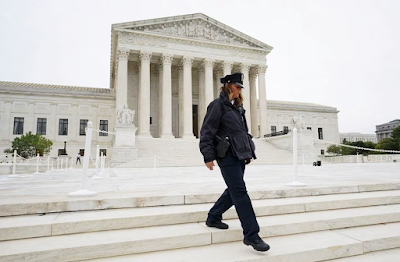Amid increased scrutinization of
deadly officer involved shootings, the Ninth Circuit Court of Appeals recently
vindicated the objectionably reasonable standard in analyzing lawsuits
involving the use of deadly force by peace officers. In Estate of Strickland
v. Nevada County, 69 F.4th 614 (9th Cir. 2023)[1],
the Ninth Circuit affirmed the district court’s dismissal for
failure to state a claim of an action brought pursuant to 42 U.S.C. § 1983 and
state law, alleging that police officers used excessive force when they shot and
killed Gabriel Strickland after he pointed a black airsoft rifle in their
direction. The Court held that the responding officers’ use of
deadly force was justifiable and objectionably reasonable under the totality of
the circumstances, even though Mr. Strickland was in possession of a replica
firearm.
On January 1, 2020, dispatch received
reports that a man was walking on a residential road with “what appeared to be
a shotgun” slung over his shoulder. Officers from Grass Valley Police
Department and Deputies from Nevada County Sheriff’s Office responded to the
scene. The responding personnel recognized Strickland and knew he was homeless,
suffered from mental health issues, and had been released from custody days
before.
The officers maneuvered their patrol
vehicles around Strickland and surrounded him with service weapons drawn. The
officers immediately ordered him to put down the gun. Strickland held the gun
away from his body, said, “It’s a BB gun,” and then slapped the gun with his
hand, making a noise that sounded more like plastic than metal. The officers
continued to yell commands to Strickland to drop the gun and that they could
not confirm the firearm was fake. Strickland pointed to the orange tip on the
barrel. One officer responded, “You could have painted that…we don’t want to
kill you.” Strickland replied, “I’m not doing nothing wrong.” Until then,
Strickland stood with the barrel pointing at the ground.
One
officer tried tasing Strickland but failed to attach and disarm him. Seconds
later, Strickland lowered the barrel toward the officers, who then shot and
killed Strickland. Strickland’s Estate filed suit alleging excessive force under
42 U.S.C. section 1983 and California law.
The Appellate Court considered whether the officers here employed an “objectively unreasonable” amount of force under the “totality of the circumstances.” See Brooks v. Clark County, 828 F.3d 910, 920, 922 (9th Cir. 2016). The Court explained that this inquiry required balancing “the nature and quality of the intrusion on the individual’s Fourth Amendment interests against the countervailing governmental interests at stake.” Graham v. Connor, 490 U.S. 386, 396 (1989). These factors included:
1. “The type and amount of force inflicted.”
2. “The severity of the crime at issue.”
3. “Whether the suspect posed an immediate threat to the safety of the officers or others.”
4. “Whether the suspect was actively resisting arrest or attempting to evade arrest by flight.”
The appellate court noted that other factors should be considered, including “the availability of less intrusive alternatives to the force employed, whether proper warnings were given, and whether it should have been apparent to officers that the person they used force against was emotionally disturbed.” S.B. v. County of San Diego, 864 F.3d 1010, 1013 (9th Cir. 2017).
The Ninth Circuit explained that of all the use-of-force factors, the “most important” is whether the suspect posed an “immediate threat.” Bryan v. MacPherson, 630 F.3d 805, 826 (9th Cir. 2010); Mattos v. Agarano, 661 F.3d 433, 441 (9th Cir. 2011) (en banc). The Court stated that because this inquiry was about objective reasonableness, “the objective facts must indicate that the suspect posed an immediate threat to the officer or a member of the public.”
While it is “clearly established that shooting a nonthreatening suspect would violate the suspect’s constitutional rights”, the Court noted that it was well-settled under Ninth Circuit precedent that lethal force is justified if an officer has “probable cause to believe that a suspect poses a significant threat of death or serious physical injury to the officer or others.”
The Court also explained that officers can have reasonable but mistaken beliefs regarding the facts establishing the existence of an immediate threat, and “in those situations, courts will not hold that they have violated the Constitution.” Saucier v. Katz, 533 U.S. 194, 206 (2001). Thus, the Constitution even allows for an officer’s action that resulted from a reasonable “mistake of fact.” Pearson v. Callahan, 555 U.S. 223, 231 (2009). When an officer’s “use of force is based on a mistake of fact, courts ask whether a reasonable officer would have or should have accurately perceived that fact.” Torres v. City of Madera, 648 F.3d 1119, 1124 (9th Cir. 2011).
The analysis remains the same regardless of whether the weapon turned out to be a replica, given the officers’ reasonable belief that Strickland possessed a real firearm. Even in the light most favorable to Strickland, he was carrying a replica gun, disregarded multiple warnings to drop it, and pointed it at the officers. Therefore, under the totality of the circumstances, it was objectively reasonable for the officers to believe Strickland posed an immediate threat even though he only had a replica gun. The Ninth Circuit concluded that the officers’ mistaken belief that Strickland possessed a dangerous weapon was reasonable, and they were justified in the use of deadly force when he pointed it at them.
Practical
Implications:
Even in the current political climate in California, this decision upholds long-standing due process and self-defense standards pertaining to the use of deadly force. Thankfully, the appellate court recognized that officers do not have to wait until they are fired upon to confirm that a weapon is real, before they can respond to a perceived deadly threat.



